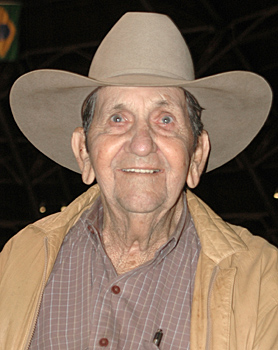 Legendary cutter, raconteur and NCHA Hall of Fame inductee John Carter passed away July 24.
Legendary cutter, raconteur and NCHA Hall of Fame inductee John Carter passed away July 24.
Born in Denton County, Texas, Carter was breaking horses by the time he was nine. His father, Homer Carter, had a band of “Spanish mares” that he bred to a Percheron stallion. The resulting colts were nearly four before Homer thought they were ready for their first saddle.
“You’d better be bowed up when you got up there,” John said of those rough-string days on his father’s farm where he also broke a white Brahman bull. The bull was the first of his breed in North Texas and Homer bought him in 1937 to start his own herd. In order to dispel rumors about the Brahman’s man-eating disposition, Homer had John and his brother ride “Tag” as proof his docile disposition.
Carter said he left home at 13 to work as a cowhand, until he joined the services in 1942. When he returned from duty, he married Jerry. Their sons, Punk and Roy, were born in 1946 and 1951.
He saw his first cutting at the 1948 Fort Worth Fat Stock Show, when George Glascock and Benny Binion’s gelding won. Since Carter had always ridden a “handling horse,” the cutting horses made quite an impression. Soon John was using one of his father’s mares to cut, although Marge already had a reputation as a roping horse.
“She was a Waggoner-bred mare,” Carter recalled. “A little dun mare, broncy, but nice. My brother-in-law borrowed her one time and said that he couldn’t stop her, so he roped a fence post. Tore the saddle off of her and liked to killed him.”
One day when John was hauling Marge in his 1946 Studebaker pickup, he slid into a ditch and the mare was killed. “It was a year before I told him,” says John, remembering the dreaded moment when his father learned the news.
Carter said his first cutting horse was half-Tennessee Walker and half-Quarter Horse. “She’d ‘saddle’ to the herd but she’d really work a cow,” said Carter. Then he rode Brian H for Bob Hunsaker. “I won the first big cutting that I went to and that kind of spoiled me,” Carter admits. “I thought I was King Kong.”
In the beginning, Carter received a lot of help from Bob Burton, who owned the great cutting champion Miss Nancy Bailey and the celebrated Paint mare, Calamity Jane. “He’d help you until you beat him, and then he’d cuss you,” recalled Carter.
Carter’s big break came when he went to work for B.A. “Barney” Skipper Jr. of Longview, Texas, wealthy oilman who chartered planes to fly Poco Lena from coast to coast when he was campaigning her in the late 1950s.
“I worked for $200 a month and broke 40-head of horses,” Carter said. “When I sold Poco Mona (to Edgar Brown) for $20,000, I went with her and Skipper told me, ‘Boy, I had you in my will.’Â I told him, ‘The way things are going, you’re going to outlive me.'”
Brown also employed Matlock Rose, Bubba Cascio, and Amye Gamblin. “We had the top six horses in the country in that barn,” said Carter. “At one time we were riding 100 horses. He would tell us if one beat us to buy it.”
As the years went by, Carter kept up with the changing times. “I rode a lot of those feather-legged horses that would buck you off in a New York minute, but if you rode them far enough they were pretty good. What we called a good horse back then wasn’t anything compared to now. But we don’t drive a Model-T anymore either.”
Carter was the go-to man for settling the herd at the Futurity for decades, a role he reprised at the NCHA Futurity Champions Cup in 2011.
He enjoyed watching his children, grandchildren and great grandchildren excel at cutting, was inducted into the NCHA Riders Hall of Fame in 1989 and the Members Hall of Fame in 2000. A list of the great horses he watched reads like a Who’s Who of cutting horse history.
“Marion’s Girl was one of the greatest mares that I’ve ever seen,” he said. “Sugar Vaquero rung his tail and jumped up and down because he was an athlete. Jessie James was a nice, ill, cow-eating athlete.
“But there’s a bunch of good ones now,” he added in 1994. “Back then you’d go to a 100-horse cutting and have ten horses to beat. Now you go to a 100-horse cutting and you have 99 to beat. Its a lot different, and cutting has come along with the times. That’s good, but if you don’t think that youth takes over, you’re a complete idiot. That’s just life.”
Services for the legendary John Carter will be held Monday, July 29 at 6 p.m. in Will Rogers Memorial Coliseum in Fort Worth. In lieu of flowers, the family has asked that donations be made to the NCHA Foundation, 260 Bailey Ave., Fort Worth, TX 76107, to support the National High School Rodeo Association Finals cutting.
